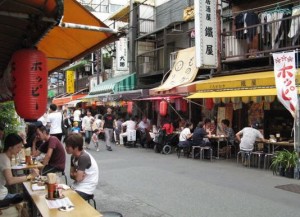
小さい店
In the article “Why Are There So Many Small Shops in Japan?” the authors Mak and Sunder introduce how small speciality shops and restaurants are a prevalent and ubiquitous part of Japanese culture. Mak and Sunder describe the role of shopping in the daily lives of Japanese people in particular. The omnipresence of shops, particularly small ones, is construed as being related to factors such as modes of public transportation, relevant legislation, the Japanese diet, and small living spaces of Japanese people. The authors also give a brief summary of some common types of Japanese stores such as large department stores, konbinis, and 100 yen stores.
Although the article argues that legislation is one of the reasons why so many small speciality shops continue to thrive in Japan, I am not completely in agreement with that statement, which I found to be surprising. While I understand that in comparison to other countries, Japan has stricter laws regarding protection of the rights of small shops and their owners, the very fact that the article also mentions the boom of department stores as well proves that perhaps the relation between the number of large department stores and the number of small shops is not so simply an inverse trend. In my opinion one of the things that is emphasized about Japanese goods is that quality and packaging is of utmost importance. Therefore, the smaller and more specialized stores fill niches that large departmental are not able to fill. Generally speaking, one is probably more inclined to patronize a specialized store when searching for a specific thing in particular. Although departmental stores conveniently tend to carry a large variety of goods, proximity to one’s home and ability to easily navigate the store can be potential downsides to shopping at a larger store.
Furthermore, after reading the article on small shops, it led me to think about the cultural importance of these small shops that can be found all over Japan. Therefore, upon visiting Kichijoji, home to a large number of small and specialized stores, I discovered that there is indeed a level of cultural charm connected with narrow alleys and the smaller stores. Even though Kichijoji is such a busy place with stores of various sizes carrying such a wide variety of goods, even many of the smaller stores were well patronized. For instance, a small restaurant serving donburi and chirashi had filled all its counter seats at around one in the afternoon on a Wednesday. Tokyo is such a bustling city that I think going into areas with smaller shops and restaurants is like a breath of fresh air; although they too may be crowded, the atmosphere changes as the shape of the spaces do. The smaller spaces tend to come with a more traditional feel or just a generally feeling of being more like home. They also make the landscape more interesting by adding character and variety to the endless skyscrapers and large department stores.
I personally find the smaller shops more appealing because they differ from chain stores where you basically know you will find same products uniformly presented to you. Although the Mak and Sunder article talks about how small shops have survived to this day in Japan, it also mentions the decline of such shops in recent years and the projected decline for their futures. One thing I did notice about going around the area of small shops in lanes at Kichijoji was that many of the stores were actually closed at the time I was there. By closed I do not necessarily mean permanently so but rather wish to question if a lack of customers accounts for this phenomenon. If it does indeed a symptom of the decline of small shops, then I think it is indeed a shame. One important thing I have taken away from this reading and assignment is to appreciate the smaller stores and the next time I have to choose between a large department store and a small store, I am likely to go for the latter.











